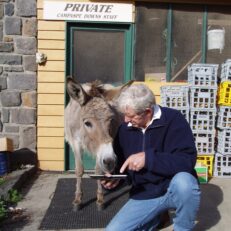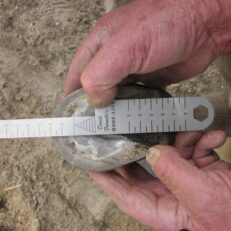The donkey’s hoof differs quite a lot from the horse’s hoof. The donkey’s hoof pastern angle is broken down; that is the natural and the correct way of the donkey’s hoof.
From the sole view, the conformation of the donkey’s hoof also differs from the horse’s hoof; where a horse’s hoof capsule is ideally an even thickness all the way around, a donkeys hoof capsule is thicker at the toe. But the buttress of the heel of a donkeys hoof actually ends further forward from the critical junction of the frog back at the heel.
The donkey’s hoof/pastern angle is not in line (not parallel) as in the horse. P3 is much more upright and so the centre point of balance is actually at the active tip of the frog (in other words it is 19mm further forwards than in the horse).
My HOOF-LINE is not calibrated for donkeys, but can still be used accurately for donkeys by placing the BOTTOM of the triangle on the TIP of the frog! Trimming the hoof to a 50:50 measurement from toe to heel from that pint will leave the heel buttresses at the correct height while allowing the frog and the heel bulbs to do their work as traction devices.
In the donkey’s foot, the bulbs of the heel are much more pronounced than that of a horse, and this is why the donkey frog is set back much further than the point of balance of the horses foot. The donkey relies on this bulb, (almost like a camel’s foot) to act as a traction device, or a cushioning device for hard terrain.
So to achieve the correct hoof pastern angle on a donkey is a little more difficult than on a horse, because the actual junction of the widest part of the frog is a lot further back than the actual buttress of the heel that the donkey needs to walk on.
And in all cases, you will find that the heels of the donkey’s foot are left longer to achieve this correct donkey-footed or broken hoof pastern angle.
The danger here in trimming a donkey’s foot, much like trimming a horse, is that because these side walls come back very straight; IF we leave the hoof too high, they tend to flare out.
So it is still very important to control the flares in the heels of the donkey’s foot.
Also, if you leave the heels too high, the front of the donkey’s foot tends to flare forward, and this thickness tends to become huge, then you get hoof wall separation, and seedy toe.
The donkey has been introduced into our country, and walking on soft ground is not ideal at all – a donkey is a beast of burden, it is suited to an arid climate where the ground is hard and rocky and in that terrain the angles wear down exactly as nature intended.
In our milder climate, especially in Southern Australia, there is no hardness on the ground to wear the donkey’s hoof down. The danger here is that these heels grow up too high, the toe grows down too long, and the heels begin to flare out sideways, and become very unstable.
To trim a donkey’s hoof, you need very few tools.
You need a sole knife – there are dozens of different styles on the market. There is a flat bladed knife – it is sharpened on both sides for cleaning out the dirt on the sole. There is a single bladed knife, which is right handed, but you can also push it with your left hand to clean out the sole. It has a little loop at the end to get in down along the side of the frog to clean out the channel. There is a loop knife which is short in the blade and long in the handle, so that you can get a lot more pressure in the blade and a lot better control. A good loop knife is a lot more expensive, but it does give a lot more advantage over the other knives, where those blades are actually too long to get a lot of pressure on the blade
All these knives can be sharpened, and they should be sharpened regularly to make them easier to use.
You also will need a rasp and handle.
PIC
Now, this donkey lived in very soft pasture, and the owners were totally oblivious to his need for hoof care until it was too late, and the feet could not be resolved.
The donkeys hoof grows at the same rate as the horse’s hoof, and should be attended to every 6-10 weeks, depending on the type of terrain.
Most donkeys need to be tied up with a very short lead rope in order to trim their feet.
They are creatures of habit, and not many donkeys will give their hoof willingly like a horse, but they will allow you trim their feet under sufferance as long as they know that they can’t get away.
The occasional very domesticated donkey can be cross tied in a shoeing bay just like a horse. Some will allow you to trim without using any restraint, but this is rare.
One particular donkey had to be tied up short, and as I lifted his first leg, he threw himself on the ground, still tied up, with all four feet in the air. He didn’t struggle, and allowed all four feet to be trimmed, groaning the whole time, but without so much as a kick. But then he would refuse to stand up until he was not only untied, but had the halter removed. He was so unique that he had his own special chapter in my first book.
He was never unhappy to see me the next time, but he always went through exactly the same format.



